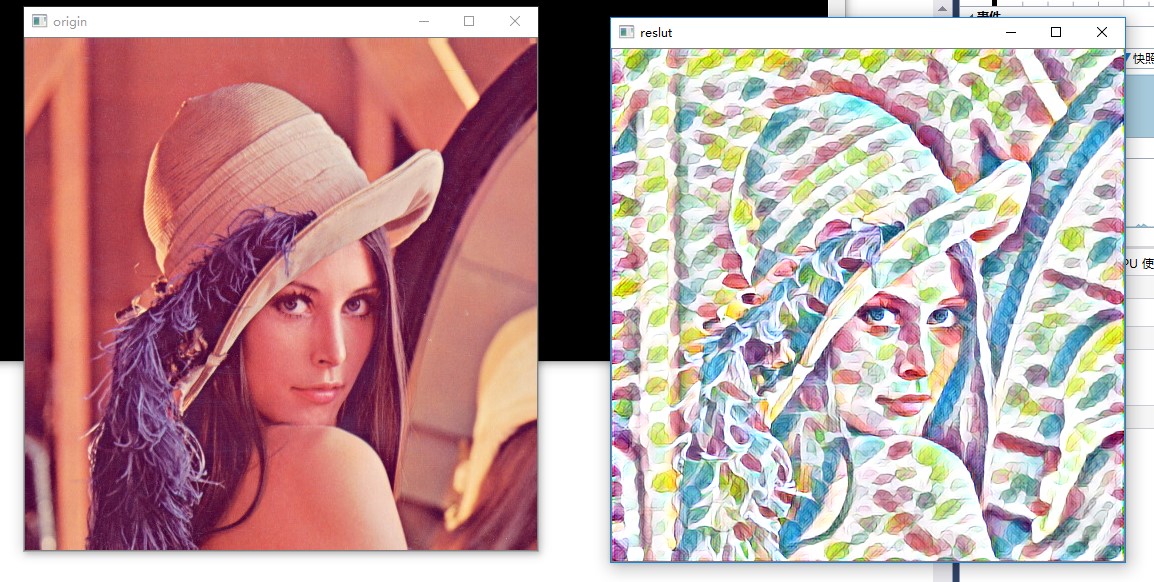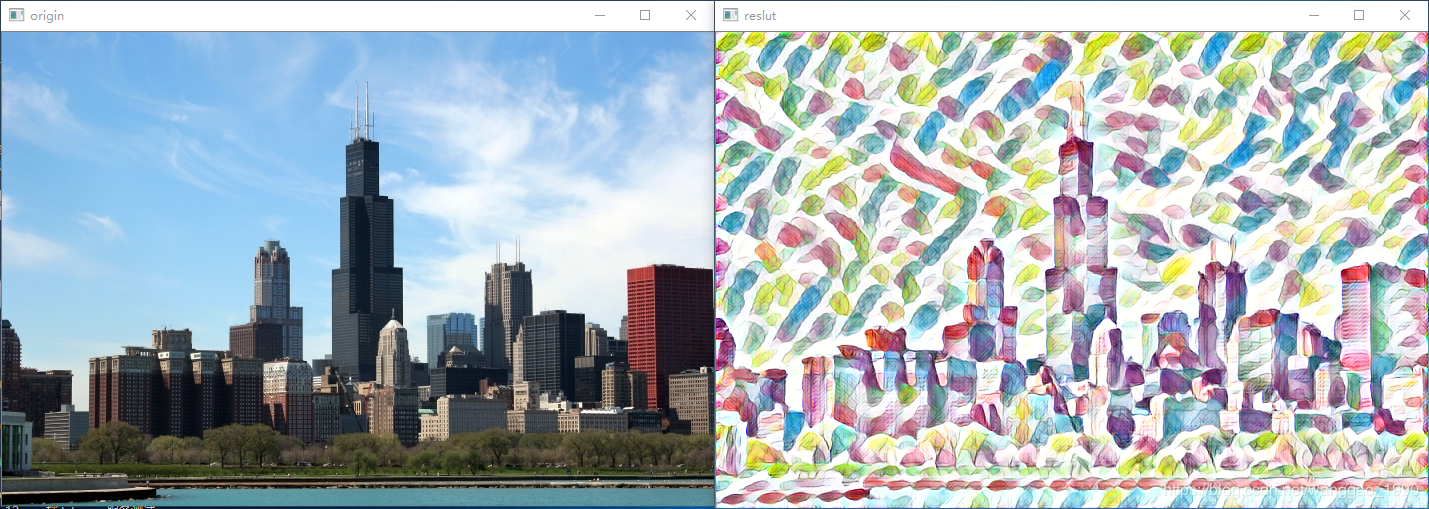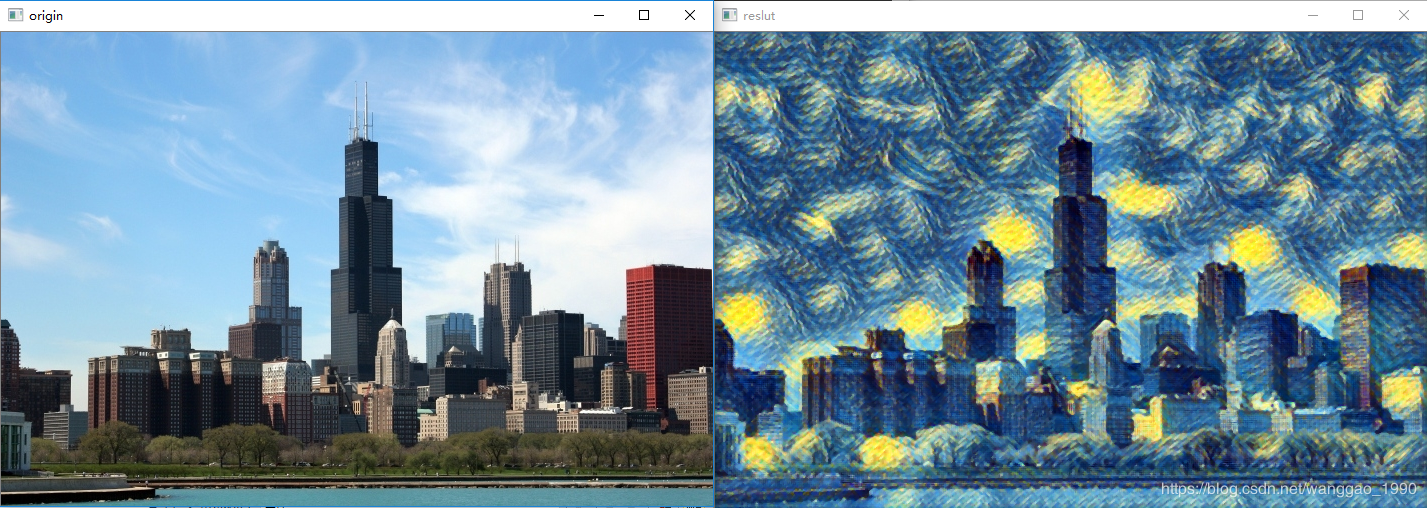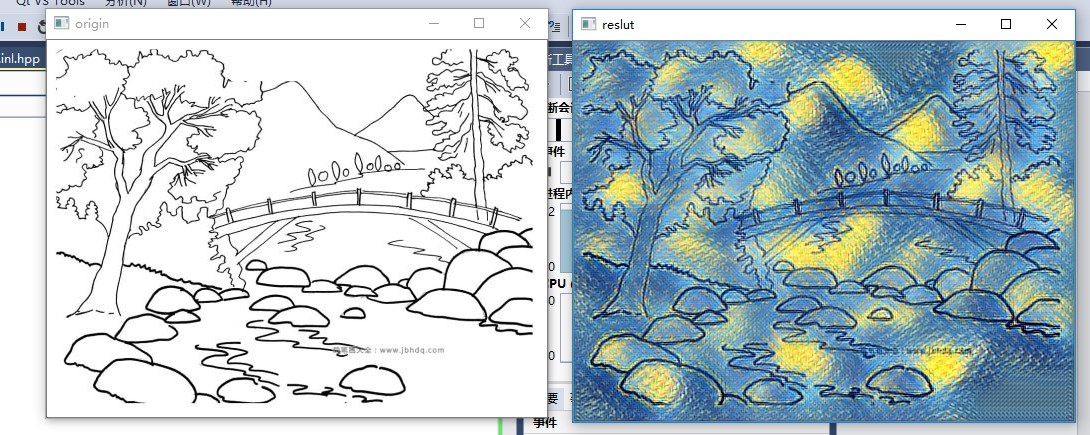OpenCv dnn模块扩展研究(1)--style transfer
一、opencv的示例模型文件
// This script is used to run style transfer models from '
// https://github.com/jcjohnson/fast-neural-style using OpenCV
#include <opencv2/dnn.hpp>
#include <opencv2/imgproc.hpp>
#include <opencv2/highgui.hpp>
#include <iostream>
using namespace cv;
using namespace cv::dnn;
using namespace std;
int main(int argc, char **argv)
{
string modelBin = "../../data/testdata/dnn/fast_neural_style_instance_norm_feathers.t7";
string imageFile = "../../data/image/chicago.jpg";
float scale = 1.0;
cv::Scalar mean { 103.939, 116.779, 123.68 };
bool swapRB = false;
bool crop = false;
bool useOpenCL = false;
Mat img = imread(imageFile);
if (img.empty()) {
cout << "Can't read image from file: " << imageFile << endl;
return 2;
}
// Load model
Net net = dnn::readNetFromTorch(modelBin);
if (useOpenCL)
net.setPreferableTarget(DNN_TARGET_OPENCL);
// Create a 4D blob from a frame.
Mat inputBlob = blobFromImage(img,scale, img.size(),mean,swapRB,crop);
// forward netword
net.setInput(inputBlob);
Mat output = net.forward();
// process output
Mat(output.size[2], output.size[3], CV_32F, output.ptr<float>(0, 0)) += 103.939;
Mat(output.size[2], output.size[3], CV_32F, output.ptr<float>(0, 1)) += 116.779;
Mat(output.size[2], output.size[3], CV_32F, output.ptr<float>(0, 2)) += 123.68;
std::vector<cv::Mat> ress;
imagesFromBlob(output, ress);
// show res
Mat res;
ress[0].convertTo(res, CV_8UC3);
imshow("reslut", res);
imshow("origin", img);
waitKey();
return 0;
}







Training new models
To train new style transfer models, first use the scriptscripts/make_style_dataset.py to create an HDF5 file from folders of images.You will then use the script train.lua to actually train models.
Step 1: Prepare a dataset
You first need to install the header files for Python 2.7 and HDF5. On Ubuntuyou should be able to do the following:
You can then install Python dependencies into a virtual environment:
# Install Python dependencies# Work for a while ...
# Exit the virtual environment
With the virtual environment activated, you can use the scriptscripts/make_style_dataset.py to create an HDF5 file from a directory oftraining images and a directory of validation images:
All models in thisrepository were trained using the images from theCOCO dataset.
The preprocessing script has the following flags:
--train_dir: Path to a directory of training images.--val_dir: Path to a directory of validation images.--output_file: HDF5 file where output will be written.--height,--width: All images will be resized to this size.--max_images: The maximum number of images to use for trainingand validation; -1 means use all images in the directories.--num_workers: The number of threads to use.
Step 2: Train a model
After creating an HDF5 dataset file, you can use the script train.lua totrain feedforward style transfer models. First you need to download aTorch version of theVGG-16 modelby running the script
This will download the file vgg16.t7 (528 MB) to the models directory.
You will also need to installdeepmind/torch-hdf5which gives HDF5 bindings for Torch:
luarocks install https://raw.githubusercontent.com/deepmind/torch-hdf5/master/hdf5-0-0.rockspecYou can then train a model with the script train.lua. For basic usage thecommand will look something like this:
The full set of options for this script are described here.
OpenCv dnn模块扩展研究(1)--style transfer的更多相关文章
- 如何使用 Opencv dnn 模块调用 Caffe 预训练模型?
QString modelPrototxt = "D:\\Qt\\qmake\\CaffeModelTest\\caffe\\lenet.prototxt"; QString mo ...
- 手把手教你使用LabVIEW OpenCV DNN实现手写数字识别(含源码)
@ 目录 前言 一.OpenCV DNN模块 1.OpenCV DNN简介 2.LabVIEW中DNN模块函数 二.TensorFlow pb文件的生成和调用 1.TensorFlow2 Keras模 ...
- OpenCV自带dnn的Example研究(4)— openpose
这个博客系列,简单来说,今天我们就是要研究 https://docs.opencv.org/master/examples.html下的 6个文件,看看在最新的OpenCV中,它们是如何发挥作用的. ...
- OpenCV自带dnn的Example研究(3)— object_detection
这个博客系列,简单来说,今天我们就是要研究 https://docs.opencv.org/master/examples.html下的 6个文件,看看在最新的OpenCV中,它们是如何发挥作用的. ...
- [C4W4] Convolutional Neural Networks - Special applications: Face recognition & Neural style transfer
第四周:Special applications: Face recognition & Neural style transfer 什么是人脸识别?(What is face recogni ...
- fast neural style transfer图像风格迁移基于tensorflow实现
引自:深度学习实践:使用Tensorflow实现快速风格迁移 一.风格迁移简介 风格迁移(Style Transfer)是深度学习众多应用中非常有趣的一种,如图,我们可以使用这种方法把一张图片的风格“ ...
- (E2E_L2)GOMfcTemplate在vs2017上的运行并融合Dnn模块
GOMfcTemplate一直运行在VS2012上运行的,并且开发出来了多个产品.在技术不断发展的过程中,出现了一些新的矛盾:1.由于需要使用DNN模块,而这个模块到了4.0以上的OpenCV才支持的 ...
- 神经风格转换Neural Style Transfer a review
原文:http://mp.weixin.qq.com/s/t_jknoYuyAM9fu6CI8OdNw 作者:Yongcheng Jing 等 机器之心编译 风格迁移是近来人工智能领域内的一个热门研究 ...
- 课程四(Convolutional Neural Networks),第四 周(Special applications: Face recognition & Neural style transfer) —— 2.Programming assignments:Art generation with Neural Style Transfer
Deep Learning & Art: Neural Style Transfer Welcome to the second assignment of this week. In thi ...
随机推荐
- ISCC之Re1
IDA打开,调试选ELF,跟踪main函数 发现有一个not_the_flag函数,跟进去 这里判断了一下a1的值是否为42,大致判断引号里面的有可能是flag,直接放到Linux下运行 提交不要有任 ...
- egg.js 完整实例2后台管理系统
项目地址 github.com/richard1015… 技术栈 Vue.js.iview.websocket.Amap 演示地址: 后台管理 schoolmgr.zhuzhida.vip 前台展示 ...
- 【独家】K8S漏洞报告 | CVE-2019-1002101解读
kubectl cp漏洞CVE-2019-1002101分析 Kube-proxy IPVS添加flag ipvs-strict-arp 近期bug fix数据分析 ——本期更新内容 kubectl ...
- 文本编辑器Vim/Neovim任意代码执行漏洞(CVE-2019-12735)
受影响版本: Vim < 8.1.1365, Neovim < 0.3.6 前提:开启modeline 0x01 开启modeline 在你的home下的.vimrc文件中增加一行: se ...
- sshd安全加固
常见的防护措施: ——用户限制,黑白名单 ——更改验证方式(密码——>密钥对) ——防火墙..... 修改 sshd 配置文件 /etc/ssh/sshd_config -port 3389 # ...
- oracle删除重复数据,只保留一条
比如,某个表要按照id和name重复,就算重复数据 delete from 表名 where rowid not in (select min(rowid) from 表名 group by id,n ...
- java spring boot 导出/下载文本文件操作(包含写文本文件)
内容简介 本文主要内容为使用java把内容写入文本文件,并实现下载/导出的功能. 实现步骤 1. controller层 @ResponseBody @RequestMapping(value = & ...
- 解决 spring boot 线程中使用@Autowired注入Bean的方法,报java.lang.NullPointerException异常
问题描述 在开发中,因某些业务逻辑执行时间太长,我们常使用线程来实现.常规服务实现类中,使用 @Autowired 来注入Bean,来调用其中的方法.但如果在线程类中使用@Autowired注入的Be ...
- K Edit Distance
Description Given a set of strings which just has lower case letters and a target string, output all ...
- YAML_14 tags给指定的任务定义一个调用标识,以后不用重复整个过程,只需要执行tags标签的部分
ansible]# vim adhttp.yml --- - hosts: cache remote_user: root tasks: - copy: src: /r ...
